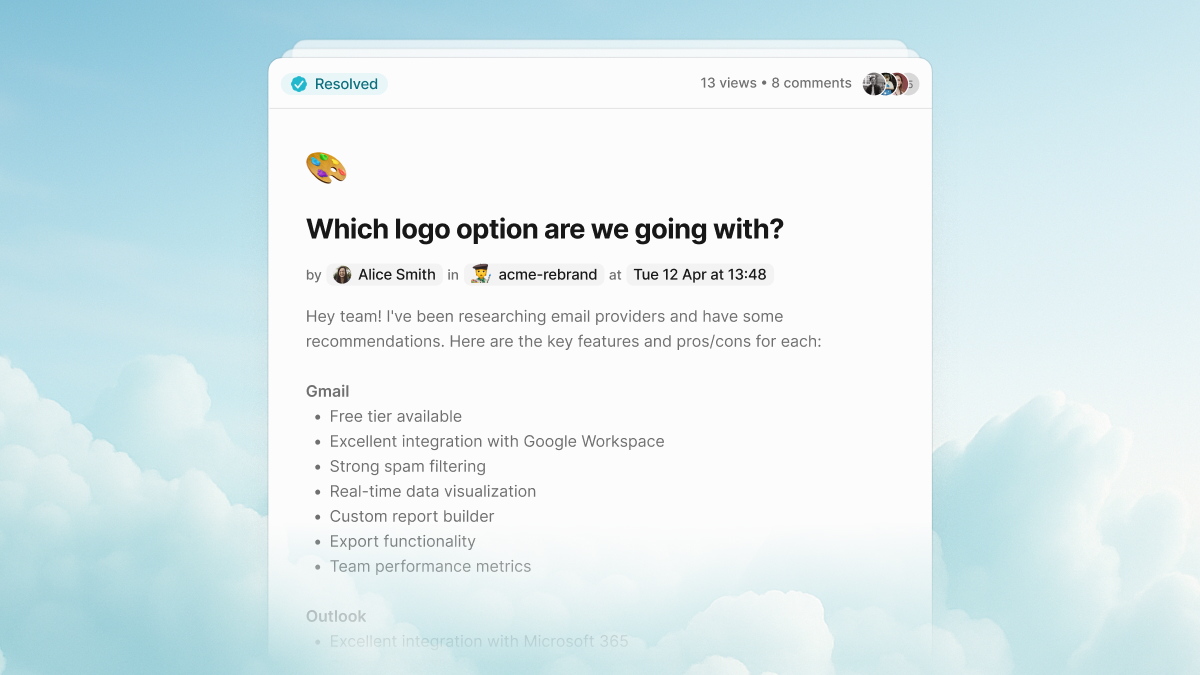Microsoft Teams costs half the price of Slack and includes video conferencing for 300 people. Slack charges more but offers better integrations and simpler setup. Teams costs less but Slack delivers superior collaboration software flexibility.
User numbers reveal business preferences: Teams dominates with 320 million daily users compared to Slack’s 42 million, yet many businesses still choose Slack. The reason comes down to philosophy: Teams builds an all-in-one Microsoft workspace, while Slack creates a flexible integration hub for team messaging.
Quick Comparison Overview
- Market share: Teams leads (37% vs 13%)
- Pricing: Teams significantly cheaper ($6.25 vs $9 monthly)
- Video conferencing: Teams built-in (300 vs 15 participants)
- Integrations: Slack more flexible (2,600 vs 1,400 apps)
- Microsoft ecosystem: Teams seamless, Slack requires workarounds
- Ease of use: Slack simpler, Teams more complex
Slack vs Teams: Complete feature comparison
| Feature | Slack | Microsoft Teams |
|---|---|---|
| Standalone pricing | $9/user/month | $4/user/month |
| Bundle pricing | No bundle | $6.25/month (Microsoft 365 Basic) |
| Video participants | 15 maximum | 300 maximum |
| Meeting duration | 50 minutes | 30 hours |
| Third-party apps | 2,600+ | 1,400-2,000 |
| File storage | External only | 1TB OneDrive included |
| Daily active users | 42 million | 320 million |
| Breakout rooms | No | Yes |
| Screen recording | Third-party | Built-in |
| AI features | Business+ plan | Copilot integration |
Microsoft Teams for business: strengths and weaknesses
Strengths
Unbeatable value: $6.25 monthly gets you Teams plus Outlook, SharePoint, OneDrive, and core Microsoft apps. Slack costs $9 for business communication alone.
Video excellence: Built-in conferencing supports 300 participants for 30 hours. Includes breakout rooms, recording, transcription, and Together Mode.
Microsoft integration: Seamless access to Word, Excel, PowerPoint, and other Office apps directly within Teams. No switching between platforms.
Enterprise ready: Advanced compliance, security controls, and governance features built for large organisations.
Weaknesses
Complexity overload: The interface confuses users by cramming too many features together, making simple team communication difficult.
Microsoft lock-in: Works best when your entire tech stack runs on Microsoft. Other integrations feel clunky.
Setup burden: Requires IT knowledge for proper configuration. Not suitable for quick team setup.
Message organisation: Poor threading and channel structure compared to Slack’s focused approach.
Slack for teams: pros and cons
Strengths
Integration ecosystem: 2,600+ apps connect seamlessly. Works with any tool combination your team already uses.
User experience: Clean, intuitive interface focuses on messaging without feature overload.
Threading: Organised conversation threads keep discussions focused and searchable.
Flexibility: Works with any tech stack. No vendor lock-in or ecosystem requirements.
Weaknesses
Video limitations: Basic video calls limited to 15 participants. Most teams need third-party solutions like Zoom.
Higher cost: $9 monthly per user without any included productivity apps or storage.
Feature gaps: Missing built-in file storage, document collaboration, and calendar integration.
AI pricing: Advanced features require $18 monthly Business+ plan.
Hidden Costs and Considerations
Teams’ gotchas:
- Requires Microsoft 365 subscription for full functionality
- Advanced features locked behind expensive enterprise plans
- Complex licensing model with multiple tiers
- Third-party app integration costs extra
Slack’s limitations:
- Video conferencing requires separate Zoom/Google Meet subscriptions
- No included file storage or productivity apps
- Guest access pricing adds up quickly
- AI features significantly increase monthly costs
Market Reality Check
User numbers reveal market preferences: Teams’ 320 million daily users vs Slack’s 42 million shows which collaboration software businesses choose. Large enterprises pick Teams for Microsoft ecosystem integration and cost efficiency. Startups and creative agencies prefer Slack for better team messaging flexibility and ease of use.
The 37% vs 13% market share reflects business priorities: Teams wins on price and features, Slack wins on user experience and flexibility.
How to Choose the Right Platform
Choose Microsoft Teams if:
- Your organisation already uses Microsoft 365
- Budget constraints require maximum value per dollar
- Video conferencing is central to daily operations
- You need enterprise compliance and security features
- Team size exceeds 100 people
Choose Slack if:
- You use diverse software tools requiring deep integrations
- Team communication and organisation are priorities
- Quick setup and ease of use matter
- Your workflow depends on non-Microsoft productivity tools
- Budget allows for premium business communication experience
Consider Cushion as a third alternative
Both Teams and Slack compromise. Teams overwhelms small teams with enterprise complexity, while Slack’s pricing hurts growing businesses. Most teams want straightforward collaboration software without vendor lock-in or feature overload.
Cushion delivers focused team collaboration without the baggage. You get organised discussions, unlimited message history, and proper project management at a fraction of Slack’s cost. No Microsoft ecosystem requirements or integration headaches.

Many teams use Cushion for internal work and keep Teams or Slack for client communication. Internal productivity improves while maintaining external compatibility. The hybrid approach costs less than either platform alone.
You avoid Teams’ complexity and Slack’s pricing while keeping the collaboration features that actually matter for daily work.
TLDR
Teams wins on price and video features but creates complexity overload. Slack dominates integrations and user experience but costs significantly more without including productivity apps.
For Microsoft-focused organisations, Teams provides better value. For diverse tech stacks, Slack justifies its premium pricing through superior integrations and team messaging capabilities.
Most small to medium teams benefit from Cushion for internal collaboration while maintaining Teams or Slack for external communication. You get focused productivity tools without enterprise complexity or premium pricing.
